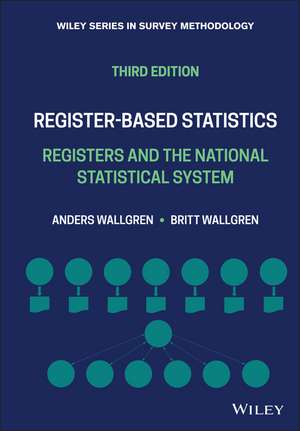Register–based Statistics, Third Edition – Registers and the National Statistical System: Wiley Series in Survey Methodology
Autor A Wallgrenen Limba Engleză Hardback – 23 mar 2022
Din seria Wiley Series in Survey Methodology
- 24%
 Preț: 643.28 lei
Preț: 643.28 lei - 9%
 Preț: 1009.73 lei
Preț: 1009.73 lei - 9%
 Preț: 1058.54 lei
Preț: 1058.54 lei - 9%
 Preț: 869.51 lei
Preț: 869.51 lei - 9%
 Preț: 1052.25 lei
Preț: 1052.25 lei - 9%
 Preț: 895.15 lei
Preț: 895.15 lei - 9%
 Preț: 1164.87 lei
Preț: 1164.87 lei - 9%
 Preț: 1215.09 lei
Preț: 1215.09 lei - 5%
 Preț: 673.14 lei
Preț: 673.14 lei - 9%
 Preț: 863.27 lei
Preț: 863.27 lei - 9%
 Preț: 767.98 lei
Preț: 767.98 lei - 9%
 Preț: 797.85 lei
Preț: 797.85 lei - 5%
 Preț: 1227.71 lei
Preț: 1227.71 lei - 9%
 Preț: 1083.99 lei
Preț: 1083.99 lei - 9%
 Preț: 1121.24 lei
Preț: 1121.24 lei - 9%
 Preț: 867.03 lei
Preț: 867.03 lei - 9%
 Preț: 1139.17 lei
Preț: 1139.17 lei - 9%
 Preț: 1041.73 lei
Preț: 1041.73 lei - 9%
 Preț: 923.82 lei
Preț: 923.82 lei - 9%
 Preț: 1688.43 lei
Preț: 1688.43 lei - 9%
 Preț: 877.64 lei
Preț: 877.64 lei - 9%
 Preț: 888.52 lei
Preț: 888.52 lei - 8%
 Preț: 646.44 lei
Preț: 646.44 lei - 8%
 Preț: 548.16 lei
Preț: 548.16 lei - 9%
 Preț: 732.07 lei
Preț: 732.07 lei - 5%
 Preț: 609.85 lei
Preț: 609.85 lei - 8%
 Preț: 586.37 lei
Preț: 586.37 lei - 8%
 Preț: 515.80 lei
Preț: 515.80 lei - 8%
 Preț: 599.46 lei
Preț: 599.46 lei - 8%
 Preț: 556.13 lei
Preț: 556.13 lei - 8%
 Preț: 675.49 lei
Preț: 675.49 lei - 9%
 Preț: 718.76 lei
Preț: 718.76 lei - 9%
 Preț: 703.76 lei
Preț: 703.76 lei - 9%
 Preț: 721.37 lei
Preț: 721.37 lei - 9%
 Preț: 723.58 lei
Preț: 723.58 lei - 9%
 Preț: 842.68 lei
Preț: 842.68 lei - 23%
 Preț: 594.41 lei
Preț: 594.41 lei - 32%
 Preț: 609.09 lei
Preț: 609.09 lei - 33%
 Preț: 825.03 lei
Preț: 825.03 lei - 30%
 Preț: 465.72 lei
Preț: 465.72 lei - 31%
 Preț: 456.38 lei
Preț: 456.38 lei - 28%
 Preț: 417.54 lei
Preț: 417.54 lei - 29%
 Preț: 414.89 lei
Preț: 414.89 lei - 31%
 Preț: 506.19 lei
Preț: 506.19 lei - 29%
 Preț: 447.94 lei
Preț: 447.94 lei - 29%
 Preț: 677.04 lei
Preț: 677.04 lei
Preț: 518.91 lei
Preț vechi: 751.14 lei
-31% Nou
99.32€ • 107.93$ • 83.49£
Carte indisponibilă temporar
Specificații
ISBN-10: 1119632374
Pagini: 288
Dimensiuni: 176 x 241 x 21 mm
Greutate: 0.7 kg
Ediția:3rd Edition
Editura: Wiley
Seria Wiley Series in Survey Methodology
Locul publicării:Chichester, United Kingdom
Notă biografică
Anders Wallgren and Britt Wallgren worked for many years in teaching and research as senior lecturers in statistics at Stockholm, Linköping and Örebro universities. They have also worked as consultants for several Swedish manufacturing industries. In connection with these consulting assignments, they began working with corporate administrative registers and developed statistical methods for business intelligence. After their academic career, they came to Statistics Sweden and worked for about 20 years at the Department of Research and Development. They worked mainly with survey methodology for the statistical registers which form the basis for the production of official statistics in Sweden. Since 2011 they have provided courses and consulting services on behalf of the Inter-American Development Bank in several Latin American countries and in the Caribbean.
Cuprins
Descriere
REGISTER-BASED STATISTICS Rediscover this authoritative guide to register-based statistics filled with significant new improvements In the newly revised Third Edition of Register-based Statistics: Registers and the National Statistical System, Anders Wallgren and Britt Wallgren deliver a robust exploration of how register-based statistics can be used to its fullest potential. The authors describe how statistical institutes can work on long-term projects to improve administrative systems, as well as estimation methods that can improve the quality of statistical estimates based on registers with quality problems. Readers will also discover how to improve the ways register-statistical issues are introduced, as well as how to create population registers. Finally, the authors draw on their experience from teaching and consulting in several countries to explain how to implement register-based statistics. Key features of the third edition: * Discusses the problems new register countries face * Explains how registers will improve the efficiency of the national statistical system * Clarifies the importance of the system approach * Describes how a statistical population register can be created * Registers-based statistics require new skills and understanding of new concepts * Many important quality indicators are described * Explains difficult topics in a pedagogic way Perfect for staff at national statistical institutes and administrative and ministerial authorities belonging to national statistical systems, Register-based Statistics will also prove to be an indispensable resource for undergraduate and graduate students in statistics programs and courses, as well as survey researchers and practitioners.
